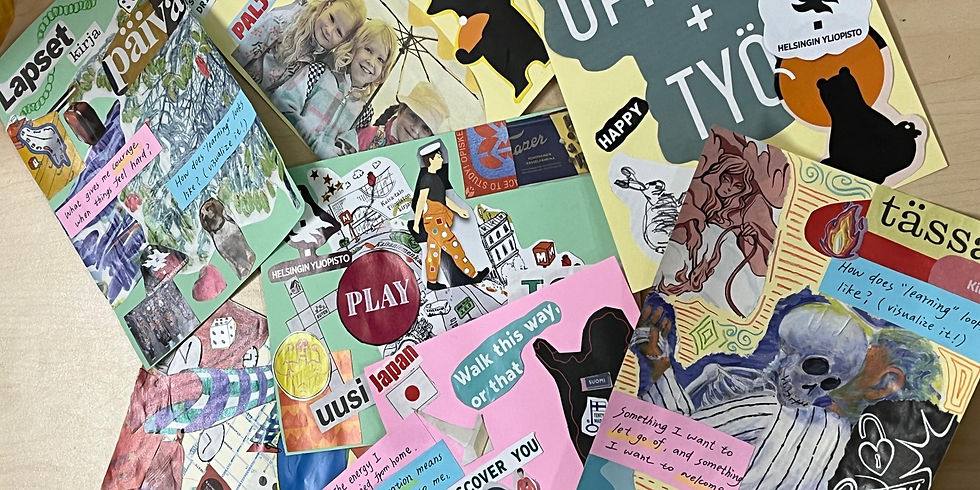Why does fungus make me cry? The power of storytelling in learning through neuroscience lenses
- Ana Esther R. de Camargo

- Dec 1, 2023
- 5 min read
Author: Ana Esther R. de Camargo
I proudly describe myself as having tough skin. I used to say you need a lot of effort to make me feel emotional or interested in something. I didn't cry at my Grandpa's funeral. I didn't cry when my favorite pet died. And still, there I was … watching the 5th episode of The Last of Us and crying like a baby. It was not even normal crying. It was a loudly super shameful ugly crying!

If you live under a rock and don't know what The Last of Us (TLoU) is, it is a TV show produced by HBO and based on a game series of the same name. In the post-apocalyptic world, we follow Joel - a middle-aged man - trying to cross the country to deliver his "cargo" Ellie to a group of rebels. 20 years before the present of the story timeline, humankind was infected by the fungus Cordyceps which transformed the majority of the population into a new version of zombies. More than just killing a lot of infected, TLoU takes the audience on an emotional rollercoaster through their characters' struggles, and if you don't drop a tear in every episode, you are already dead inside. By the end of episode 5, I was in shock, trying to understand why in the name of God I was crying, and at the same time, why suddenly I was so obsessed with fungus, sign language, and social behavior. Some hours later I was already a specialist on Cordyceps, Karl Marx, vaccines, and hearing disability tools.
Then I had my first neuroscience epiphany: Wow! Storytelling is a powerful tool to make me learn about things I used to not care about! At this point, you might be thinking the same thing I was: Does neuroscience explain these phenomena? I decided to give it a try and check.
Well, I knew from previous studies that emotion is one of the main pillars for learning, not only its identification but also recognition and triggering for good learning environments (Damasio, Ekman, Murphy, Plutik; all researchers that got us to this point). I also knew from those same studies that the more positive the emotion and activeness, the better. But … wait… so… How does a passive activity such as watching TV, and a show that makes me cry every episode, create such an impact?
If you have worked for media productions (as I have), you know the answer might be storytelling. The definition of storytelling is the skill or ability to pass a message through a narrative that compels the audience with emotional triggers. Storytelling techniques have been largely studied and applied by filmmakers, cinematographers, and advertisers for over a century. More recently, the education field has also become interested in storytelling as part of methodologies due to its power of engagement. Methodologies based on problem-solving (such as game-based learning, for example) use storytelling as their backbone. The more digital technologies advance, the more the discussion of storytelling in education comes to life.
How does neuroscience explain storytelling and learning? I'll be honest and say it wasn't as easy to find as I thought. Luckily, I found a very interesting Spanish article (yes, I can read in Spanish) in which the authors have done a literature review on neuroscience studies and storytelling. Veronica Pereira and Beatriz Lago explain 2 components storytelling must attend to be successful according to neuroscience:
1 - Emotion: It is a basic premise of storytelling in general. The narrative must evoke emotion in the audience. In media productions, it is important that the emotion inflicted varies; otherwise, the audience would lose interest by just feeling one "tone" of emotion (only happiness, for example). To be able to create such variation and achieve a common understanding, storytellers spread through the arc of the story the most common emotions of the wheel (such as rage, sadness, happiness, fear, and disgust)

All of us can trigger all of those emotions differently. So, the second trick storytellers use in their stories is to create situations the majority of the audience can identify by memory, and this is pretty important. The more emotion attached to a situation, the more it is retained in our memory. So, by creating fictional stories, storytellers try to recreate situations the audience might have emotionally attached to their memories (friendship, breakups, family discussions, falling in love). This is the most effective way of generating an emotional reaction because the audience will project themselves and their memory feelings into the fictional characters.

2 - Attention: Our capacity for attention is limited. If the audience doesn't pay attention to the story, then it is not worth it. To get the audience's attention, Storytellers create the first emotion-evoking memory, as explained in the emotion section. However, instead of ending as the audience remembers or imagines, they surprise the audience by pivoting the direction of the story, creating an unexpected feeling. That way the audience's attention is renewed several times during the narrative. Some neuroscience research even says that negative events or messages call more the attention of the audience than positive events (Bolls; Lang; Potter. 2001). This technique of pivoting the story to evoke a new emotion and attention is very common also at the end of episodes for tv shows or Marvel Movies. When they are the last thing we see, we call them Cliff Hangers. Do you remember what you felt in this scene?

Yeah, right?! I know!
The result of those 2 neurological phenomenons (triggering emotion and driving attention) is the emergence of engagement. In other words, engagement is when the emotion evoked also causes other cognitive or physical reactions (such as crying or laughing). When engagement is achieved, the audience tries by themselves to fill the gaps the narrative left behind, and this is where learning happens.
I'm not a biologist, and I'm never going to be. However, I know everything about cordyceps because a show once made me cry. And I must admit, this show will probably make me cry and learn for a very long time.

What about you? Have you learned something through my storytelling in this text? I would love to know (:
References
Aldama, F. L. (2015). The science of storytelling: Perspectives from cognitive science, neuroscience, and the humanities.
Caminotti, E., & Gray, J. (2012). The effectiveness of storytelling on adult learning. Journal of Workplace Learning, 24(6), 430-438.
Crespo-Pereira, V., & Legerén-Lago, B. (2017). Diseño televisivo a través de la neurociencia. El profesional de la información (EPI), 26(6), 1047-1055.
Ekman, P., Levenson, R. W., & Friesen, W. V. (1983). Autonomic nervous system activity distinguishes among emotions. science, 221(4616), 1208-1210.
Gulino, P. J., & Shears, C. (2018). The science of screenwriting: The neuroscience behind storytelling strategies. Bloomsbury Publishing USA.
Kim, D., & Li, M. (2021). Digital storytelling: Facilitating learning and identity development. Journal of Computers in Education, 8, 33-61.
Martinez-Conde, S., Alexander, R. G., Blum, D., Britton, N., Lipska, B. K., Quirk, G. J., ... & Macknik, S. L. (2019). The storytelling brain: how neuroscience stories help bridge the gap between research and society. Journal of Neuroscience, 39(42), 8285-8290.
Mellon, C. A. (1999). Digital storytelling: Effective learning through the internet. Educational Technology, 39(2), 46-50.
Mckee, R. (2017). Story. Substância, Estrutura, Estilo e os princípios da escrita de roteiro. The neuroscience behind storytelling strategies. Arte & Letra.
Murphy, F. C., Nimmo-Smith, I. A. N., & Lawrence, A. D. (2003). Functional neuroanatomy of emotions: a meta-analysis. Cognitive, affective, & behavioral neuroscience, 3(3), 207-233.

Ana Camargo is a game & play designer with nearly a decade of experience and also a researcher in applied linguistics and critical pedagogy. Hailing from Brazil, Ana is an advocate for diversity, black feminism, and decolonizing education. Known for challenging stereotypes, she defies expectations by loving sunlight, hot weather, fruits, soccer, and dancing. Ana aims to amplify the voices of the silent and unseen, contributing to a more equitable world both inside and outside academia.
Key words: Neuroscientific Phenomena, Engagement, Emotion, Storytelling




Comments